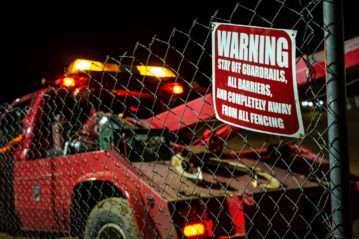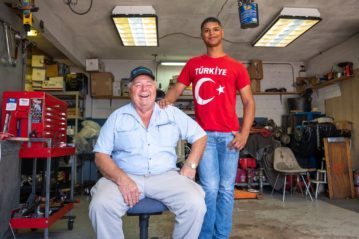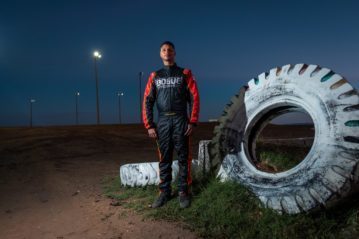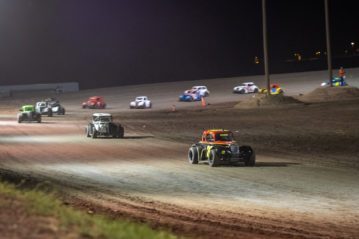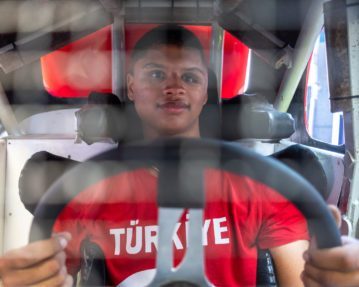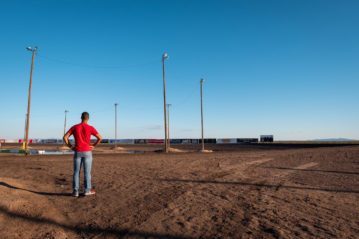
But now night has fallen, and from the grandstand or even higher above in the track marshal tower, Southern New Mexico Speedway looks like the center of the world. A clay oval, banked inward like a bowl, flooded white with halide light in the middle of all that desert darkness.
Nine cars, referred to as “Legends,” enter the track, cresting onto it from the far side of one of the speedway’s steepest embankments. On the basis of shape alone, they have the vintage appearance of cars from the late 1930s—squared bodies and narrow noses, vertical radiator grills and wheels covered by only a single solid piece acting as a fender. But, like all race cars, they’re covered in sponsor logos and sport big, legible numbers on their sides.
The cars arrange into a quick formation. Two columns condensed together as a single unit. In this formation they complete a quiet, deliberate lap. Hundreds of onlookers watch from the stands—bleachers, essentially, behind a high steel fence.
A flagman stands on a reinforced plank cantilevered out over the start/finish line. The cars round the turn leading to the front stretch, and the flagman waves a green flag.
Together, the drivers stomp on their accelerators, creating a noise so loud it feels like it occupies every inch of open air in the New Mexico desert, a noise so fierce you can feel it battering the muscles in your jaw, rattling the bones in your chest.
It takes only seconds before one of the drivers, in a jet-black and apple-red Legend sporting a decal of the number 37, peels away from the formation, accelerating through the first bend and out through the back straight to a noticeable lead. Behind him, the drivers jostle for position like wolves over scraps, sometimes as many as three drivers side by side at once vying for second place.
But the leader continues forward uncontested. Within three laps, he’s put nearly half the track between himself and the other cars. And by the tenth and final lap of the heat race, as he threatens to lap the slowest driver, his lead is insurmountable.
This is artistry, victory, dominance.
This is Josh Jackson.
—
“I don’t know what to tell you. We’ll do everything we can, but your son isn’t going to make it through the night.”
These are the words doctors gave Ginger Jackson, Josh’s mother, on the night of August 8, 2015.
She had witnessed the crash, a three-car accident on the back straight of Southern New Mexico Speedway. In the accident, Josh’s car lifted off the ground and inverted. Another driver careened into his exposed roll cage. The race was stopped and emergency crews struggled to pry Josh from the confines of his sprint car.
“At first, I didn’t realize it wasn’t a typical crash,” Ginger says. “I mean, he’s been on fire, he’s rolled his car, he’s been in a million different crashes. Until the ambulance arrived, it wasn’t something I was worried about.”
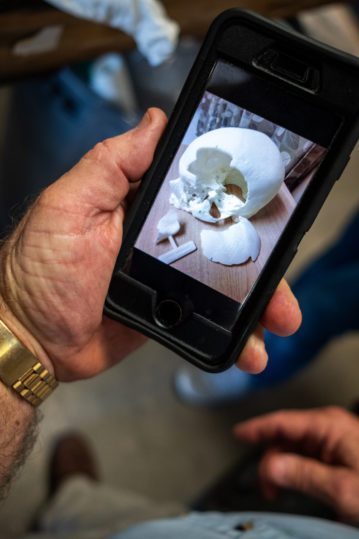
Errant posts on social media—both from eyewitnesses on the track and officials from the event—erroneously reported Josh’s death.
Much to the contrary, Josh clung to life.
“He lived,” Ginger says. “But I don’t remember taking a single breath that night.”
Though clinically alive, Josh demonstrated only minimal brain function throughout a three-week coma. Near-constant “neurostorms”—sudden attacks of his nervous system—kept him at a high risk of stroke. Doctors didn’t know if he would ever wake—and if he did, whether he’d live the rest of his life in a wheelchair. Trapped without the ability to speak, the ability to walk, or the ability to race ever again.
—
Josh arrived at QLI’s rehabilitation program in December 2015, nearly four months after his injury.
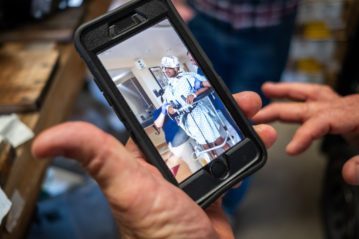
Upon admission, Josh walked without a wheelchair, although his gait was described as “ataxic,” a reference to the involuntary movement present in the wild stepping motions of his right leg. He also battled a lack of strength and coordination in his right hand—his dominant hand. Rudimentary, tactile tasks—tying shoes, for instance—were too complex for Josh to complete unassisted.
His cognitive challenges were every bit as numerous. He managed simple objectives, daily routines like bathing and eating, with relative independence, but required external cueing from therapists to work through more complicated processes. His mind resembled a record player whose needle was lifting off the vinyl surface time and time again, always in need of being set back in place.
In some ways, the damage to Josh’s brain manifested most clearly in his struggle to speak.
All of QLI’s clinical teams identified his struggle utilizing words with specificity. Complex phrases and abstractions, like numbers and time, posed the greatest challenge to his expressive speech. Communication, as a result, entailed a mixture of broken speech, simple repeated phrases, gestures, and facial expressions.
His rehabilitation became a two-pronged effort, both a push to generate measurable physical and cognitive gains, and a campaign to weave those burgeoning abilities into something more. A framework, a foundation. The blueprint for success in the life Josh looked to lead after QLI.
It required neuromuscular re-education—essentially, retraining the brain to send messages to the body’s extremities and muscles—and it was a process that necessitated enormous quantities of formal exercise and functional routine. By mid-December, Josh spent upward of forty hours every week with physical therapists, occupational therapists, and speech-language pathologists. Honing proper gait form, employing resistance training and electrical stimulation to restore voluntary movement and coordination in his right arm, and building word-finding strategies and problem-solving techniques through intricate and novel situations. At all times, his brain faced challenges, making incremental but noticeable steps toward improved function.
But life, as Josh knew, is more than training in isolated spaces. It’s about putting skills to the test. Cutting a chicken breast with his weak hand. Walking up and down stairs, over curbs, across broken parking lot concrete. Reading passages for class and being able to summarize them in one’s own words. Combining all of these abilities in tandem to build a new sense of independence.
This confluence of ability reached a culmination in February 2016, when QLI helped Josh return to the race track. Partnering with Joe’s Karting, a go-kart racing company based out of Council Bluffs, Iowa, QLI found a way to stoke Josh’s competitive flame.
Racing was Josh’s one true passion. Together, QLI and Joe’s Karting created a specialized training program that not only got Josh back to racing but provided a rigorous physical and cognitive exercise. Joe’s Karting modified the course to isolate Josh’s weak right arm, sometimes forcing him to drive the entire track using a single hand on the steering wheel.
“I can’t imagine any other healthcare provider doing what QLI did for Josh,” Ginger says. “It was so unorthodox, but it was working.”
Rehabilitation transformed from a process of training for recovery into a process of training for life. Bombarded on all sides with opportunities to use his newfound skills—and to do so successfully—Josh had begun to reclaim his identity.
“The care he’d received in the hospitals were great stepping stones,” says Ginger, “but QLI gave him back his life.”
—
Pick any 21-year-old man out of a crowd. Josh’s life doesn’t look so different.
Living once again in Albuquerque, New Mexico, Josh keeps an active daily routine, starting every morning before sunrise with a trip to a local gym. His six-foot-four frame has taken on additional, noticeable mass—all muscle, all hard work. His posture is different, more confident. Even his walk, that most frustrating of physical hurdles, is an opponent Josh has wrestled under control.
“I like to work out,” Josh says. “I like to take care of myself. Eat clean. I don’t drink soda. That stuff’s poison.”
Physical health serves him well, as most days during the work week he’s hoofing it across Central New Mexico Community College’s main campus, slinging his textbooks and homework over his shoulders in a sporty backpack. In time, he’ll graduate with a business degree.
In class, Josh is an active student. His notebooks are scribbled full of quick notes and unanswered questions, memorandums written with his right hand. It’s a sign that, even years post-rehabilitation, Josh tests himself with the smaller details. The ones that matter the most. Likewise, he’s unafraid of asking questions in class, or even spending time afterward gleaning extra tips from the instructors.
Classmates take a shine to him, too—sometimes knowing his story, sometimes not, but always magnetized to his sense of humor and his unquantifiable talent for bringing out the ornery and happy-go-lucky sides of those around him.
Outside of class, he works at WAC Upfitters, a business owned by his grandfather that installs specialized equipment into law enforcement vehicles across the region. Josh, now equipped with a New Mexico driver’s license, finds himself responsible for driving across the state, and often into other states, to retrieve cars and trucks for the business.
The act of driving itself functions as one of the best lenses into Josh’s progress. Albuquerque is a labyrinthine network of frontage roads and densely packed expressways. And the intersecting interstate roads, I-45 and I-20, flood the city with aggressive drivers making unpredictable decisions. It’s a stressful environment for any driver, much less one who has had to relearn how to process complex, dynamic information as the result of a brain injury.
Josh remains comfortable behind the wheel all the same, whether driving out of the city on assignment for the shop or to and fro between the college campus and the local indoor go-kart center, where he stops a couple of times a week to try and put his name a couple of spots higher on the track’s all-time leaderboard.
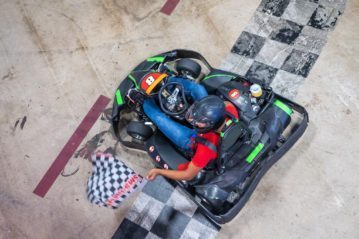
“I still get really competitive,” Josh says, before buckling himself into a kart and peeling off a series of blistering laps that hew close to his record.
Watching him live life on his terms, it’s easy to remember how much Josh has lost. It’s easy, too, to remember how far Josh has come. Before the injury, Josh was tearing through the ranks of the national racing scene. A career in NASCAR felt like a foregone conclusion. A future with no ceiling, a straight shot with no restrictor plate.
But that drive remains. His hunger to race. Something fundamental in his composition that can’t live without it. That’s where Josh hasn’t changed, where he continues to chase his passion:
On the race track.
—
It’s race day.
Josh and his family have driven two hundred twenty miles south to compete. Tonight marks the second-to-last race to ever be held at Southern New Mexico Speedway. In a few weeks’ time, it will be demolished, reclaimed by the Las Cruces desert and all its barren stillness.
The gravity of this fact, like many things, is not lost on Josh. But he observes it with little more than a competitive nonchalance.
“I want to win tonight. But I want to win every night,” he says. Then he laughs. A race is a race. Tonight, for all Josh’s personal history with the speedway, is no different.
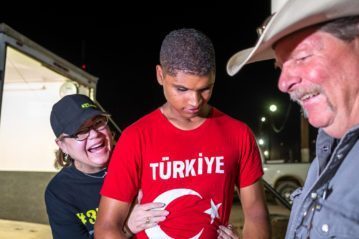
“Everyone watched him fight back,” Ginger says. “A lot of them were here when the crash happened. A lot of them saw his journey on social media. That gives them ownership of his recovery too.”
She adds: “Now Josh is everyone’s miracle.”
—
“The track never stays the same,” Josh says, looking at Southern New Mexico Speedway from the high bank of its first corner, standing by a pair of spray-paint-white tractor tires at the end of a low wall.
“The dirt moves every race. Slides around. The cars get loose in the corner and you lose your grip. You have to find your own line and follow it.”
He stands there for a while. Watches a race from behind one of the speedway’s emergency tow vehicles. Then he wanders back down the hill to the racing trailer where he paces around his car, checking every panel, every bolt, every nut, gauging the pressure of every tire, eyeing every millimeter between the steering column and the seat.
The realities of racing were the hardest part of Josh’s recovery. But they remain the hardest part for Ginger as well, who, as Josh climbs into the tight cockpit of the #37 Legend for the night’s main event race, takes her leave away from the trailer. She waits in the family car, parked with the lights off not far from the grandstands. She no longer watches the races themselves, but keeps a nervous eye on the electronic leaderboard on the backstretch. There, the numbers of the cars leading the race are displayed from first to fifth.
But it’s Josh’s passion. It’s everything that matters. She refuses to let anything come between her son and his passion.
“I want him to live his life the way he chooses to,” she says. “I have to let him do that. I may not like it, but it boils down to the fact that racing is his life.
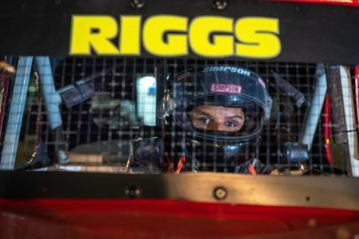
After his display of dominance in the night’s earlier heat race, Josh has qualified for the feature, which pits 17 drivers against one another in a 20-lap finale.
Josh starts from the pole position, the very front. From the first wave of the green flag, it looks like history on repeat. The #37 car jumps out to an early lead, a lead that seems to grow with each lap. He’s visibly the fastest driver on the track.
But a three-car spinout at the rear of the pack stops the race. A yellow caution flag is thrown, signaling the drivers to gather together and pace around the track slowly until the race can begin again. The 17 drivers regroup bumper to rear bumper, as if starting fresh.
As the group roars to speed before the green flag, Josh’s car is nosed by a car at his rear driver-side wheel. Josh’s car turns sideways and coasts into the track’s center field.
Josh is unhurt, but the accident spells certain doom for his hopes of winning. Fewer than ten laps remain, and a rulebook technicality prevents him from restarting in the lead. For a moment, he remains stationary in the track center as the other drivers complete a caution lap. Then he drives back onto the track surface, gunning the #37 car to the position from which he’ll resume the race.
Dead last.
The final green flag of the race flies. Within the first half of the first lap, Josh passes three drivers. Two more by the end of a full orbit.
He weaves in, through, and between his rivals like a needle. At one point, gunning his engine through the corners as hard as he can, he throws the car into a 360-degree spin. It’s both accidental and stylish. Somehow, he remains on the track, seemingly defying physics to maintain both his place amongst the other drivers and his undeniable forward momentum.
In moments like these, you understand what you’re seeing. A prodigy, someone gifted with talent so otherworldly it wouldn’t make sense to find them anywhere else.
As the race ends, he finishes in sixth place. If the race had been two laps longer, he would have caught the leader.
For Josh, it’s a disappointing end to the night. But for his team, his fans, and his family, it’s a moment of pride. Back at the family’s trailer, Ginger greets her son with a long hug. A fellow driver visits shorty afterward to congratulate Josh, telling him that he didn’t take the loss sitting down. He fought, and that’s a good thing. That’s what he’s supposed to do. Fight.
Josh loads the #37 car into the trailer. Tonight’s loss stings, certainly, but he’ll have another shot at Southern New Mexico Speedway. One last race.
If you look, you can see something familiar in the results of the race. An analogy, some kind of mirror image. It feels like Josh Jackson’s story in microcosm. His skill and ability and irresistible dominance, all dashed by a circumstance beyond his control.
But on this night, as was the case during his recovery beyond the bleakest of hardships, those circumstances couldn’t stop him. He won’t return to Albuquerque with a win in the record books. He won’t return to everyday life entirely removed from the influence of his brain injury.
And yet, it feels like both might be only a lap away. And you’d better believe #37 is going to lead the charge to get there.
Because that’s simply what Josh Jackson does.
Categories: Brain Injury, Client Story


